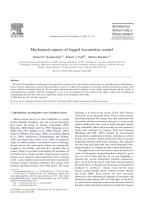Bơm ECD-V - P - Outline of Injection Volume Control
Bạn đang xem bản rút gọn của tài liệu. Xem và tải ngay bản đầy đủ của tài liệu tại đây (1.67 MB, 4 trang )
9
SERVICE TECH Vol.468 03-10
The engine ECU judges the engine conditions and driving status of the vehicle based on the information received
from the sensors. This is used to calculate the optimum fuel injection volume for the engine. The ECU then sends a
signal to the solenoid spill valve of the injection pump to control the injection volume.
Fuel injection starts the moment the cam plate forces the plunger to begin lifting. In other words, the timing of the
start of injection is determined by the position of the cam plate. Fuel is increased or decreased by controlling the timing
of the end of injection. The end of injection is the moment when the solenoid spill valve is opened and high pressure
fuel is spilt into the pump chamber.
1
1
Outline of Injection Volume Control
2
2
Control of Fuel Injection Volume
2-1 Controlling the Injection Volume
End of Injection
Cam Plate
Solenoid
Spill Valve
Begins to Lift
(Start of Injection)
ON
OFF
Cam Lift
Plunger
10
SERVICE TECH Vol.468 03-10
The engine ECU counts the pulses outputted from the speed sensor. The ECU opens (OFF) the solenoid spill
valve at a position corresponding to the number of pulses (injection end position) calculated by the ECU. The pulse
count is based on the number of NE (Engine speed) pulses counted after the toothless section of the pulsar is
detected.
If the opening time of the solenoid spill valve is delayed, the injection time is lengthened, and the injection volume
is increased.
2-2 Increasing and Decreasing the Injection Volume
Toothless Section
Engine Speed Sensor Signal
(Cam Angle)
Injection Angle (Time)
End of Injection
Lift Start
Closed
Closed
Open
Solenoid Spill Valve
Cam Lift
Increasing the Fuel Injection Volume
Injection Increase Volume
Engine Speed Sensor Signal
(Cam Angle)
Injection Angle (Time)
Cam Lift
Solenoid Spill Valve
Closed
Closed
Open
SERVICE TECH Vol.468 03-10
11
The engine ECU calculates when to open the solenoid spill valve from the signal received from the engine speed
sensor. The engine speed sensor generates a pulse when its position aligns with the tooth of the pulsar (gear)
attached to the drive shaft. The pulsar and the cam plate are unified into one unit by the coupling, so if the position
of the pulsar is detected it is possible to determine the rotation angle (position) of the cam plate.
The solenoid spill valve is directly linked to fuel injection volume control, so the responsiveness of the valve
strongly influences the injection volume. If the coil resistance is lowered to secure the operating current, the
responsiveness is faster. The solenoid spill valve is closed during fuel suction/injection, but the actuating signal is
actually a rapidly repeating ON/OFF signal.
Pulsar
Drive
Shaft
2-3 Actuating the Solenoid Spill Valves
Solenoid Spill Valve Actuating Signal
Counter Electromotive Force
End of Injection
Current
Control
Solenoid Spill Valve
Waveform
Current
Control
12
SERVICE TECH Vol.468 03-10
Based on the engine speed, accelerator opening position and the signals received from the sensors, the engine
ECU calculates the "basic injection volume" and the "maximum injection volume" for the current condition of the
engine. From these two volumes, the ECU selects the optimum value appropriate to the driving conditions and
determines the final injection volume. The "maximum injection volume" means the maximum volume of fuel that
can be pumped into the intake air under the current engine conditions.
Determined by the engine speed and accelerator position.
When the speed is constant, increasing the accelerator
opening will increase the fuel injection volume.
This is the maximum injection volume for the intake air
capacity at a certain engine speed, so that the fuel combusts
without issuing black smoke. The maximum injection volumes
calculated from the engine speed are finally determined after
correction according to factors such as the intake air pressure,
fuel temperature and intake air temperature.
3
3
Calculation of the Injection Volume
3-1 Calculating the Injection Volume
Solenoid
Spill Valve
Basic Injection
Volume
Maximum
Injection Volume
Selects the Smallest
Injection Volume
Correction
Coolant
Temperature
Sensor
Intake Air
Pressure
Sensor
Fuel
Temperature
Sensor
Intake Air
Temperature
Sensor
Decides Final
Injection Volume
Accelerator
Position
Engine
Speed
Correction
Resistor
Basic Injection Volume
Maximum Injection Volume









